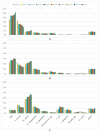Distribution of Bovine Mastitis Pathogens in Quarter Milk Samples from Bavaria, Southern Germany, between 2014 and 2023-A Retrospective Study
- PMID: 39272289
- PMCID: PMC11394622
- DOI: 10.3390/ani14172504
Distribution of Bovine Mastitis Pathogens in Quarter Milk Samples from Bavaria, Southern Germany, between 2014 and 2023-A Retrospective Study
Abstract
The objective of this study was to investigate the distribution of mastitis pathogens in quarter milk samples (QMSs) submitted to the laboratory of the Bavarian Animal Health Service (TGD) between 2014 and 2023 in general, in relation to the clinical status of the quarters, and to analyze seasonal differences in the detection risk. Each QMS sent to the TGD during this period was analyzed and tested using the California Mastitis Test (CMT). Depending on the result, QMSs were classified as CMT-negative, subclinical, or clinical if the milk character showed abnormalities. Mastitis pathogens were detected in 19% of the QMSs. Non-aureus staphylococci (NAS) were the most common species isolated from the culture positive samples (30%), followed by Staphylococcus (S.) aureus (19%), Streptococcus (Sc.) uberis (19%), and Sc. dysgalactiae (9%). In culture-positive QMSs from CMT-negative and subclinically affected quarters, the most frequently isolated pathogens were NAS (44% and 27%, respectively), followed by S. aureus (25% and 17%, respectively) and Sc. uberis (8% and 22%, respectively). In QMSs from clinically affected quarters, the most frequently isolated pathogens were Sc. uberis (32%), S. aureus (13%), Sc. dysgalactiae (11%), and Escherichia (E.) coli (11%). The distribution of NAS and Sc. uberis increased throughout the study period, while that of S. aureus decreased. From June to October, QMSs from subclinically affected quarters increased and environmental pathogens, such as Sc. uberis, were detected more frequently. In conclusion, this study highlights the dynamic nature of the distribution of mastitis pathogens, influenced by mastitis status and seasonal factors. Environmental pathogens still play an important role, especially in clinical mastitis and seasonal dependency, with the number of positive samples continuing to increase. It is therefore essential to continue mastitis control measures and to regularly monitor the spread of mastitis pathogens in order to track trends and adapt targeted prevention measures.
Keywords: bovine mastitis; incidence; mastitis pathogens; season.
Conflict of interest statement
The authors declare no conflicts of interest.
Figures




Similar articles
-
Microbial Aetiology, Antibiotic Susceptibility and Pathogen-Specific Risk Factors for Udder Pathogens from Clinical Mastitis in Dairy Cows.Animals (Basel). 2021 Jul 16;11(7):2113. doi: 10.3390/ani11072113. Animals (Basel). 2021. PMID: 34359241 Free PMC article.
-
Incidence of clinical mastitis and distribution of pathogens on large Chinese dairy farms.J Dairy Sci. 2017 Jun;100(6):4797-4806. doi: 10.3168/jds.2016-12334. Epub 2017 Apr 21. J Dairy Sci. 2017. PMID: 28434736
-
A survey of mastitis pathogens including antimicrobial susceptibility in southeastern Australian dairy herds.J Dairy Sci. 2022 Feb;105(2):1504-1518. doi: 10.3168/jds.2021-20955. Epub 2021 Dec 23. J Dairy Sci. 2022. PMID: 34955276
-
Udder infections with Staphylococcus aureus, Streptococcus dysgalactiae, and Streptococcus uberis at calving in dairy herds with suboptimal udder health.J Dairy Sci. 2016 Mar;99(3):2102-2117. doi: 10.3168/jds.2015-9487. Epub 2016 Jan 21. J Dairy Sci. 2016. PMID: 26805990
-
Pathogen-specific production losses in bovine mastitis.J Dairy Sci. 2018 Oct;101(10):9493-9504. doi: 10.3168/jds.2018-14824. Epub 2018 Aug 16. J Dairy Sci. 2018. PMID: 30122416
Cited by
-
Annual and Seasonal Trends in Mastitis Pathogens Isolated from Milk Samples from Dairy Cows of California's San Joaquin Valley Dairies Between January 2009 and December 2023.Vet Sci. 2025 Jun 21;12(7):609. doi: 10.3390/vetsci12070609. Vet Sci. 2025. PMID: 40711269 Free PMC article.
-
Staphylococcus aureus in Bovine Mastitis: A Narrative Review of Prevalence, Antimicrobial Resistance, and Advances in Detection Strategies.Antibiotics (Basel). 2025 Aug 8;14(8):810. doi: 10.3390/antibiotics14080810. Antibiotics (Basel). 2025. PMID: 40868004 Free PMC article. Review.
-
Profile of circular RNAs in bovine mammary tissues infected with Staphylococcus aureus.Arch Microbiol. 2025 Feb 21;207(3):67. doi: 10.1007/s00203-025-04269-4. Arch Microbiol. 2025. PMID: 39982455
-
Antimicrobial Susceptibility Patterns of Staphylococcus spp. Isolates from Mastitic Cases in Romanian Buffaloes from Western Romania.Antibiotics (Basel). 2025 May 23;14(6):537. doi: 10.3390/antibiotics14060537. Antibiotics (Basel). 2025. PMID: 40558127 Free PMC article.
References
-
- Meçaj R., Muça G., Koleci X., Sulçe M., Turmalaj L., Zalla P., Koni A., Tafaj M. Bovine environmental mastitis and their control: An overview. Int. J. Agric. Biosci. 2023;12:216–221. doi: 10.47278/journal.ijab/2023.067. - DOI
LinkOut - more resources
Full Text Sources

